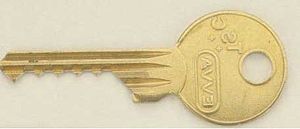Lock Bumping is a trick known to locksmiths for bypassing a cylinder lock using a specially cut key called a Bump Key. A bump key can be created by filing down a normal key of the correct type for the lock, or a bump key can be professionally cut by a key cutting store. Locksmiths refer to them as 999 keys because all cuts are made to the maximum depth setting (9).

To understand why lock bumping works, it is necessary to have some understanding of how the vulnerable lock functions. Most household locks are of the “cylinder” variety. Cylinder locks are favoured because they provide good resistance to picking whilst still being very compact and easy to install. The mechanism inside a cylinder lock is very simple. A barrel turns within a cylinder. Once the barrel has been turned though 180 degrees, it connects with a sprung mechanism to retract the shoot bolt, allowing the door to swing open.
To restrict the barrel from turning, key pins are inserted into the cylinder mounted on springs. Each pin is cut to a different height, and must be depressed to the correct depth to align correctly with the barrels “shear line”. Once this has been done the barrel will be able to rotate freely.
To prevent anyone from simply pushing the key pins down to their maximum depth, and thus – past the shear line, the key pins are protected by a set of pins called “driver pins”. These driver pins float on top of the key pins, and are long enough to slide past the shear line if pressed too far. These driver pins will then serve to block the barrel from rotating if they are pushed too far.
The correct key for the lock has multiple ridges, cut to push the driver pins to the exact depth required to align the key pins with the shear line and allow the barrel to rotate. The driver pins are now rotated inside the barrel. The key no longer has any security function to perform. It acts as a lever used to rotate the barrel. Once the barrel has slipped past the shear line, the key has no further security function. Its purpose now is to act as a lever to apply further rotation to the cylinder.
Anyone skilled in the use of lock picks will be able to manipulate the driver pins manually by feel alone, testing the correct depth for each pin and holding it in place using another tool to apply rotational pressure on the barrel. Picking a lock however, requires much practice.
Lock Bumping is the serious security threat to all doors and padlocks on houses, shops, offices, factories, caravans and mobile homes using keys. Stop it now with any of our range of Pickbuster products.
For more information on lock bumping, visit http://trade.pickbuster.co.uk/lockbumping/.
To see Chris Pankhurst demonstrating his invention Pickbuster on the QVC shopping channel, take a look at this video. Chris Pankhurst demonstrating Pickbuster on QVC.




